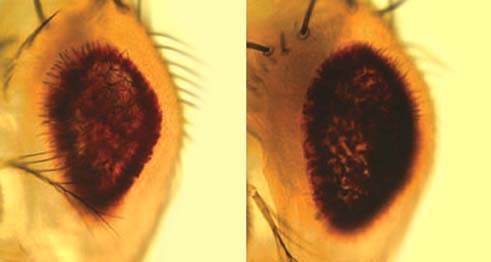
| Developing fly eyes provide Rockefeller University scientists with a tool to measure the ability of proteins to trigger cell death. The experiment above shows that excess quantities of the killer protein Reaper normally trigger the death of fly eye cells, resulting in a smaller than normal eye (left). But when levels of a ubiquitinating or "garbage disposal" enzyme called ubcD1 are reduced, Reaper can no longer function as wellas indicated by the larger eye (right). By using this and other fly techniques, Rockefeller researchers were able to show that Reaper induces natural cell death by first stimulating a guard protein, called DIAP1, to self-destruct via ubiquitination, a natural process in which unwanted proteins are tagged for destruction and subsequently disposed. |